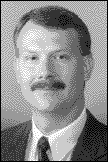From the Executive Director
 One
constant factor with nonprofit association work is the demand
for developing working relationships with other organizations.
The schedule of various meetings this fall is a good example of
this need for liaisons.
One
constant factor with nonprofit association work is the demand
for developing working relationships with other organizations.
The schedule of various meetings this fall is a good example of
this need for liaisons.
The middle of October found me traveling to Washington, DC, to represent the AASV at the Legislative Advisory Committee (LAC) of the American Veterinary Medical Association (AVMA). This committee assists in formulating AVMA legislative policy and positions on federal regulatory proposals. Each of the species specialty groups is represented in the LAC, and brings its own priorities into the meeting. Remarkably, the LAC has been able to incorporate many concerns into the legislative process.
The LAC gives the AASV a voice in Washington in addition to our own efforts and those in cooperation with the National Pork Producers Council. The veterinary profession is small in number compared to other professions. Food animal veterinarians are a single segment of the profession, with swine veterinarians a subset of that small segment. The most effective method of influencing legislation, policy, and regulations, is by leveraging our resources with other groups of similar interests.
The LAC is one of the few councils and committees within the AVMA where the allied groups name their representative. Most other AVMA representatives are elected within the AVMA's House of Delegates. The AASV is actively advocating for a process similar to the LAC for other representation within the AVMA. Groups such as the AASV will benefit by having specific charge over who is representing their interests to the AVMA.
Another event highlighted on my fall calendar is the United States Animal Health Association (USAHA) annual meeting in mid-October. The public and private sectors of veterinary medicine come together in the USAHA to solve problems. Much of the focus is on animal health problems with a regulatory aspect (usually state or federal) requiring a national consensus. Most work is done in the 34 USAHA committees.
Roy Schultz, our representative to the USAHA, has done an excellent job promotingthe interests of the AASV. His skill in navigating the course of organizational politics has allowed AASV to have input into many key issues. Beth Lautner, Paul Sundberg, Dave Pyburn, and Paul Yeske have also been instrumental in participating in the USAHA and ensuring that the interests of swine veterinarians and the pork industry are advanced.
The third week of November found me traveling back to Washington, DC, to participate in a meeting with the United States (U.S.) Agency for International Development (USAID). This is the governmental agency that works in achieving development in foreign countries and advancing U.S. foreign policy. This particular meeting was focused on animal agriculture. The USAID was interested in identifying program areas that could benefit the U.S. livestock industry and meet the foreign development goals of the agency. The AASV was the only private-sector veterinary organization involved in this discussion, and we were invited because of our participation in the pork industry and our international membership.
The USAID meeting was the first opportunity the AASV had been given to contribute to the furthering of America's foreign policy interests. My presentation focused on four main areas:
Science-based approaches are necessary when working with industry and trade issues such as foreign animal diseases, pork safety, and emerging swine diseases.
U.S. foreign policy should do no harm to the domestic production of pork. Caution needs to be exercised when dealing in sensitive areas such as non-tariff trade barriers, promotion of unfair competition with U.S. producers, and introduction of foreign animal diseases to the U.S.
Scientific interests in emerging swine diseases and syndromes extend across borders. Sharing can lead to cooperation and synergy in research, prevention, treatment, and control.
Support is needed for the essential role of the veterinarian in preserving and protecting animal health and well-being, whether in the U.S., other developed countries, or in developing countries. Funds are needed in developing countries if veterinarians are to be sufficiently trained and then supported with adequate diagnostic and therapeutic options.
My last comments involve the liaisons that the AASV has with our commercial sponsors. The AASV is able to maintain its level of programming and advocacy due to the generosity of the companies that support our association. Dues would double if this support were to disappear. The people that work for these companies are not just the holders of the money bags. They are AASV members. They are our colleagues and our friends. Take time to thank them for their support of the AASV.
A sincere apology goes out to Pharmacia and Upjohn Animal Health. A list of companies sponsoring events at our 2000 annual meeting was published in a past issue of Swine Health and Production. Unfortunately, Pharmacia's name was omitted. Pharmacia has been a loyal and substantial supporter of the AASV for many years. The Monday luncheon at the annual meeting has been graciously funded by Pharmacia for more years than I can remember. Thanks goes out to Pharmacia and its personnel for their faithful support.
The connection between any two groups or organizations is only as strong as the efforts put into the liaison. The AASV continues to search out new connections, and to put our best efforts into maintaining those that advance the interests of our members. Are we missing any connections? We just might be. If we are, then please call me or any of our officers and directors and let us know.
--Tom Burkgren
